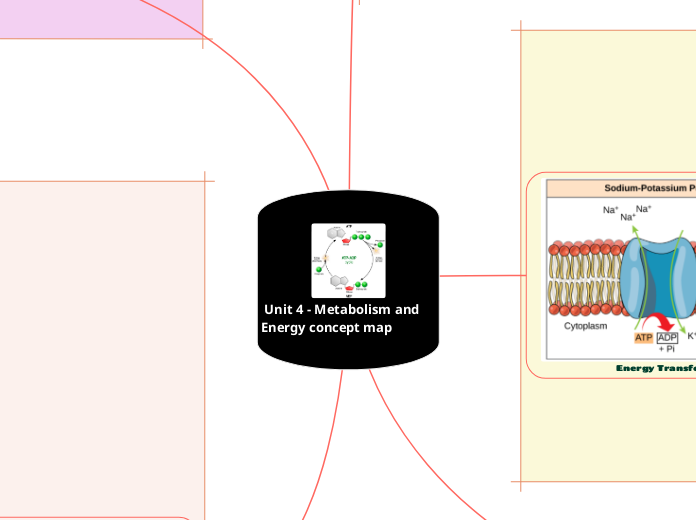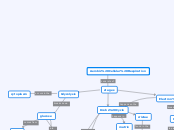Unit 4 - Metabolism and Energy concept map
Cell respiration
Anaerobic respiration
Fermentation
Ethanol Fermentation
- Conversion of pyruvate to ethanol and CO2
- Common in yeast and some bacteria
- Used in the production of alcoholic beverages
Lactate Fermentation
- Conversion of pyruvate to lactate
- Regeneration of NAD+ for glycolysis
- Common in muscle cells during intense exercise
Aerobic respiration
Electron Transport Chain (ETC)
- Series of protein complexes on the inner mitochondrial membrane
- Electrons transferred, creating a proton gradient
- Oxygen is the final electron acceptor
- ATP produced through oxidative phosphorylation
- Chemiosmosis and ATP synthase involved
Krebs Cycle (Citric Acid Cycle)
- Further breakdown of Acetyl-CoA
- Takes place in the mitochondrial matrix
- Generates NADH, FADH2, and ATP
Pyruvate Oxidation
- Conversion of pyruvate to Acetyl-CoA
- Takes place in the mitochondrial matrix
- Releases CO2 and generates NADH
Glycolysis
- Breakdown of glucose into pyruvate
- Occurs in the cytoplasm
- Generates ATP and NADH
Photosynthesis
Light Independent/Dark Reactions (Calvin Cycle)
- Occurs in Stroma of chloroplasts
Role of CO2 and O2 in Calvin Cycle
- Importance of carbon dioxide fixation
- Oxygen as a byproduct
Calvin Cycle Steps
- Carbon fixation (RuBisCO enzyme)
- Reduction of 3-phosphoglycerate to form G3P
- Regeneration of RuBP
- Overall production of glucose and other carbohydrates
Overview of the process
- Utilizes ATP and NADPH produced in the light-dependent reactions
- Carbon fixation
- Reduction and regeneration phases
Light dependent - Occurs in thylakoid
Role of Photosystems in Electron Transport
- Absorption of light energy and excitation of electrons
- Movement of electrons through the chain
- Final electron acceptor: NADP+
Photosystem I and Photosystem II
- Electron transport chain between them
- Formation of a proton gradient
Overview of the process
- Light absorption by chlorophyll
- Water splitting (photolysis)
- Generation of ATP and NADPH
Biochemical pathways
Redox reactions
Redox Regulation
- Maintaining cellular redox balance
- Significance in metabolic regulation
Role in Energy Transfer
- Electron carriers (NAD+/NADH, FAD/FADH2)
- Electron transport chain in cellular respiration
Overview of Oxidation-Reduction Reactions
- Role of electron transfer in energy transfer
- Oxidizing agents and reducing agents
Catabolic pathways - Breaking complex molecules
Relationships with other pathways
- Interplay with anabolic pathways for energy and precursors
- Regulation through feedback mechanisms
Other Catabolic Processes
- Fatty acid oxidation
- Amino acid degradation
Krebs Cycle
- Citric acid cycle reactions
- Energy and product generation
Glycolysis
- Overview and key steps
- Energy and product generation
Anabolic pathways - Building complex molecules
Nucleic Acid Synthesis
- DNA replication
- RNA synthesis
Protein Synthesis
- Transcription and translation processes
- Role of ribosomes and tRNA
Relationships with other pathways
- Integration with catabolic pathways for precursor molecules
- Regulation through feedback mechanisms
Energy Transfer
Cellular Respiration and ATP Production
- ATP generation in glycolysis, Krebs cycle, and electron transport chain
- Role of ATP in oxidative phosphorylation.
ATP Coupling
- Linking energy-releasing reactions with energy-consuming reactions
- Maintaining energy balance within the cell
ATP in Metabolism
- Involvement in anabolic reactions (energy input)
- Involvement in catabolic reactions (energy release)
Energy Storage and Release
- ATP as a short-term energy storage molecule
- Hydrolysis of ATP to ADP and inorganic phosphate for energy release
Formation of ATP
- Adenosine Triphosphate (ATP) structure
- ATP synthesis during cellular respiration and photosynthesis
Concept of metabolism
Cellular Metabolism
-Metabolic processes occurring within cells
-Production of energy for cellular activities
Metabolic Diversity in Organisms
-Variation in metabolic pathways among different species
-Specialized adaptations for specific environments
Metabolic Homeostasis
-Maintaining a balance in metabolic processes
-Adaptations to varying energy needs
Regulation of Metabolism
-Enzymes and their role
-Feedback mechanisms
Definition of Metabolism -Sum of all chemical reactions in a living organism
-Involves catabolic and anabolic pathways
Subtopic









